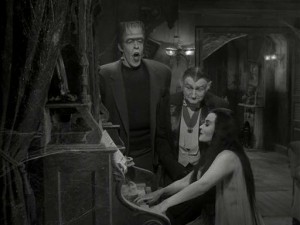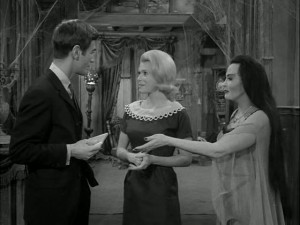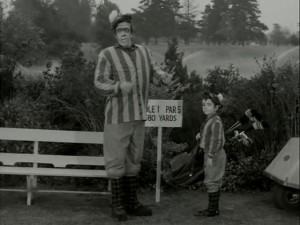The Munsters are Due on Maple Street
“Abhorred monster! Fiend that thou art! The tortures of hell are too mild a vengeance for thy crimes. Wretched devil!” – Mary Shelley, Frankenstein.
“I can’t help it. It’s the way I’m made.” – Herman Munster, The Munsters.

In the generation after World War II, suburban life got to be the big thing in America. That’s not just a physical or an economic statement, though it is. Vast new swathes of housing were being built for a new, prosperous class. Rising wages meant the average family could afford a bigger home, and the rise of the automobile meant people could live further from their workplaces.
But as I say, this wasn’t just an economic thing, it was a social thing. As more people lived in suburbia, suburbia got to be the place where stories were set. This is particularly true with regard to TV. Upwardly mobile, predominantly white suburban dwellers had to own their TVs, and so TVs had to tell stories about white suburban dwellers. Sure, you could still find Lucy in her New York flat, or the stock bumpkins of Petticoat Junction, but mostly it was the comfortable suburban existence of the Cleevers, the Andersons and the Douglasses. And of course, the monsters.

There were a lot of monsters, if you think about it. Real life American white post-war suburbia has a reputation of being incredibly homogeneous, yet TV suburbia burst with aliens, witches, genies, ghosts, talking animals, vampires, Frankenstein monsters, werewolves and whatever the hell Cousin Itt was.
The question is, why? Did the mundanity of suburbia bore the TV writers so much that they had to throw some crazy character into their sitcoms? Maybe, but why did suburbanites love it so much? This was the age of the ‘sundowner town’, so called because black workers were expected to leave before nightfall. Why were people who rejected the idea of living next door to a black person so okay with the idea of living next to Frankenstein?

What I’m getting at is, was the fictional insertion of these crazy characters into suburban life a positive thing? Was it a tacit admission that the bland homogeneity of suburbia was an illusion, and beneath it was a world of hidden craziness? Or was it the reverse – a case of all the diversity of the world being shoehorned into a life of the breadwinner/homemaker model, of mortgages, 2.4 kids and mowing lawns?
To answer that, I think you have to look at the commonalities between some of these shows. I’m looking at the Munsters, obviously, but also My Favourite Martian, Bewitched, the Addams Family and I Dream of Genie. The first thing we notice is that the fantastic elements of these show is never played down. Something out of the ordinary is never just accepted. In Martian, Genie and Bewitched, the title alien, djinn and witch are constantly battling to avoid being seen for what they are. Uncle Martin had to lie low so that the government wouldn’t find him and, presumably, ship him off to Area 51. Samantha had to pretend not to be a witch out of fear of witch hunting. And Genie… actually, I never got why Genie had to hide. Maybe because Major Nelson was a dick? I don’t know.
So this was the lesson being beamed into the living rooms of America: hide your differences, they’ll just bother people. Think of the famous Twilight Zone episode The Monsters are Coming on Maple Drive, where the aliens freak out a small suburb, and all the tiny differences between neighbours turn into irreconcilable chasms until finally the whole neighbourhood erupts into civil war. Imagine that, only imagine that the differences were real. Don’t let that happen. In private, you can let your antennae out, I guess, but in public you are John Q. Normal, capice?
This makes our last two shows really quite different. Neither the Addamses nor the Munsters gave a flying crap about any of that. They were weird freaky outsiders, but they didn’t care. Hell, they didn’t know that they were outsiders! Samantha Stevens had to pull elaborate ruses to prevent herself or her extended family from being identified with anything out of the ordinary. Granpa Munster drove a coffin-shaped car and straight up tried to bite people with his vampire fangs. It was a very different, and dare I say, a far more modern approach to dealing with people who are out of the ordinary.
Out of the Addamses and the Munsters, I always liked the Addamses more. The show was better written and better performed and that’s all there is to it. But this is an essay on the Munsters, so let’s get into what the show did and how it worked.
The Munster family consisted of father Herman Munster (Fred Gwynne), a shambling revenant made of a patchwork of corpses; his wife Lily, (Yvonne de Carlo) a vampiress, and their son Eddie (Butch Patrick) a werewolf. Also present was Lily’s father, Grandpa Munster (Al Lewis), and their ‘strange’ (ie, normal) niece Marilyn (Beverly Owen in season 1 and Pat Priest in season 2).
Herman was the breadwinner, working at a mortuary. Lily was the homemaker, working the reverse vacuum that spread dust. Grandpa was a retired immigrant grandfather, tinkering in his workshop and holding onto slightly embarrassing old-world customs like trying to bite people. Marilyn had a string of romances — each doomed to fail, but all sufficient to get a plot going. And Eddie was never funny, not even once.
When I was a kid and I watched the Munsters, amazingly I never realised that Herman was Frankenstein’s Monster. I mean, I knew he was meant to be a Monster-like character — that was obvious — but I didn’t get that he was the guy. His name was ‘Herman’ for a start, not ‘Frank’ or ‘Frankie’ or something. He had a twin brother, for goodness sake. How could Frankenstein’s Monster have a twin brother?

But, no. Herman was — canonically, in the show, literally — Frankenstein’s Monster. He was created by Victor Frankenstein but adopted by an English family named Munster. Grandpa was literally Count Dracula. Count Sam Dracula, sure, but Dracula. The Addamses were eccentric enough, but they weren’t literal, actual monsters. The Munsters were. Herman could smash through walls with his Frankenstein strength, Granpa had vampire powers plus he was a mad scientist and Eddie… All right, Eddie sucked. But the point is that the Addamses were weird but harmless, while the Munsters could have messed you up. The people who were scared of Herman and Grandpa were arguably right to be scared.
And yet the Munsters didn’t mind. They just got on with things. And people, after the initial shock of seeing them, just sort of got on with them and would soon settle down into everyday sitcom relationships — difficult neighbours, get-rich-quick schemes, comical misunderstandings or disputes with their local utilities people. That’s not to say their monstrous nature never drives the plot – in one episode, for example, Grandpa turns into a wolf and gets nabbed by park rangers – but this sort of thing was rarely central to the Munsters’ interactions with non-Munsters.
Like I say, the Munsters isn’t one of my favourite shows. Fred Gwynne and Al Lewis are clearly having the times of their life as Herman and Grandpa, but Yvonne de Carlo played Lily super bland. Marilyn was potentially interesting, but never had much thought put into her character, and Eddie was… No wait. I was about to say that he was the least funny sitcom character ever, but then I remembered the entire cast of Growing Pains. Sorry, Eddie. My bad. Oh, and Urkel. Eddie was less embarrassing than Urkel.

Where the hell was I? Oh, right. So, back to my original question. Are the fantasy sitcoms of the fifties and sixties cases of out-there characters being assimilated into suburban life, or are they about suburban life enlivened by the arrival of some cool new neighbours? Are they about accepting the stranger in your midst, or are they about reinforcing notions of social normalcy? Well, that varies somewhat from show to show. With The Munsters, the classic Universal Pictures monsters are taken away from Viseria and plunked down in some bland neighbourhood and given everyday occupations, priorities and aspirations. Definitely a case can be made for assimilation.
And yet, critically, the Munsters refuse to allow this assimilation to progress further than they choose. So in the end, if middle class white people insist on making the Munsters live in suburbia, then those are the people who’ll have to get used to the new neighbours — like it or not.



